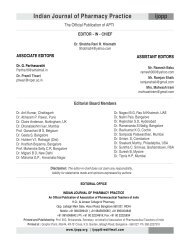Oct-Dec, 2011 - Indian Journal of Pharmacy Practice
Oct-Dec, 2011 - Indian Journal of Pharmacy Practice
Oct-Dec, 2011 - Indian Journal of Pharmacy Practice
- No tags were found...
Create successful ePaper yourself
Turn your PDF publications into a flip-book with our unique Google optimized e-Paper software.
Instructions to AuthorsIntroduction: A brief background information on what has beendone in the past in this area and the importance <strong>of</strong> the proposedinvestigation shall be given. Introduction shall end with a statement<strong>of</strong> the purpose or hypothesis <strong>of</strong> the study.Material and Methods: This section may be divided into subsectionsif it facilitates better reading <strong>of</strong> the paper. The researchdesign, subjects, material used, and statistical methods should beincluded. Results and discussion shall not be drawn into this section.In human experimentation, ethical guidelines shall beacknowledged.Results: This section may be divided into subsections if it facilitatesbetter reading <strong>of</strong> the paper. All results based on methods must beincluded. Tables, graphic material and figures shall be included asthey facilitate understanding <strong>of</strong> the results.Discussion: Shall start with limited background information andthen proceed with the discussion <strong>of</strong> the results <strong>of</strong> the investigation inlight <strong>of</strong> what has been published in the past, the limitations <strong>of</strong> thestudy, and potential directions for future research. The figures andgraphs shall be cited at appropriate places.Conclusion: Here, the major findings <strong>of</strong> the study and theirusefulness shall be summarized. This paragraph should address thehypothesis or purpose stated earlier in the paper.Acknowledgments. Acknowledgments should appear on aseparate page.Tables. Each table should be given on a separate page. Each tableshould have a short, descriptive title and numbered in the order citedin the text. Abbreviations should be defined as footnotes in italics atthe bottom <strong>of</strong> each table. Tables should not duplicate data givenin the text or figures. Only MS word table format should be used forpreparing tables. Tables should show lines separating columns withthose separating rows. Units <strong>of</strong> measurement should be abbreviatedand placed below the column headings. Column headings orcaptions should not be in bold face. It is essential that all tables havelegends, which explain the contents <strong>of</strong> the table. Tables should notbe very large that they run more than one A4 sized page. If thetables are wide which may not fit in portrait form <strong>of</strong> A4 size paper,then, it can be prepared in the landscape form. Authors will be askedto revise tables not conforming to this standard before the reviewprocess is initiated. Tables should be numbered as Table No.1Title…., Table No.2 Title…. Etc. Tables inserted in word documentshould be in tight wrapping style with alignment as center.Figures, Photographs and Images: Graphs and bar graphsshould preferably be prepared using Micros<strong>of</strong>t Excel and submittedas Excel graph pasted in Word. These graphs and illustrationsshould be drawn to approximately twice the printed size to obtainsatisfactory reproduction.Specification <strong>of</strong> Legends/values in Graphs Font Arial, size- 10pt, Italics- None] Diagrams made with <strong>Indian</strong> ink on whitedrawing paper, cellophane sheet or tracing paper with handwritten captions or titles will not be accepted. Photographsshould be submitted only on photo-glossy paper. Photographsshould bear the names <strong>of</strong> the authors and the title <strong>of</strong> the paper on theback, lightly in pencil. Alternatively photographs can also besubmitted as 'jpeg/TIFF with the resolution <strong>of</strong> 600 dpi or more'images. Figure and Table titles and legends should be typed on aseparate page with numerals corresponding to the illustrations.Keys to symbols, abbreviations, arrows, numbers or letters used inthe illustrations should not be written on the illustration itself butshould be clearly explained in the legend. The complete sets <strong>of</strong>original figures must be submitted. Legends should be in the presenttense (e.g., 'Illustration shows ...'). Subjects' names must not appearon the figures. Labels should contrast well with the background.Images should be uniform in size and magnification. Illustrationsshould be free <strong>of</strong> all identifying information relative to the subject andinstitution. Written permission for use <strong>of</strong> all previously publishedillustrations must be included with submission, and the sourceshould be referenced in the legends. Written permission from anyperson recognizable in a photo is required. Legends must be doublespaced, and figures are numbered in the order cited in the text. Colorprints shall be submitted only if color is essential in understandingthe material presented. Label all pertinent findings. The quality <strong>of</strong> theprinted figure directly reflects the quality <strong>of</strong> the submitted figure.Figures not conforming to acceptable standards will be returned forrevision. Figures should be numbered as Fig.1, Fig.2 etc. ; Figuresinserted in word document should be in square wrapping style withhorizontal alignment as center.Resolution: Drawings made with Adobe Illustrator and CorelDraw(IBM/DOS) generally give good results. Drawings made inWordPerfect or Word generally have too low a resolution; only ifmade at a much higher resolution (1016 dpi) can they be used. Files<strong>of</strong> scanned line drawings are acceptable if done at a minimum <strong>of</strong>1016 dpi. For scanned halftone figures a resolution <strong>of</strong> 300 dpi issufficient. Scanned figures cannot be enlarged, but only reduced.Figures/Images should be submitted as photographic qualityscanned prints, and if possible attach an electronic version (TIFF/JPEG).Chemical terminology - The chemical nomenclature used must bein accordance with that used in the chemical abstracts.Symbols and abbreviations - Unless specified otherwise, alltemperatures are understood to be in degrees centigrade and neednot be followed by the letter 'C'. Abbreviations should be those well<strong>Indian</strong> <strong>Journal</strong> <strong>of</strong> <strong>Pharmacy</strong> <strong>Practice</strong> Volume 4 Issue 4 <strong>Oct</strong> - <strong>Dec</strong>, <strong>2011</strong>
















